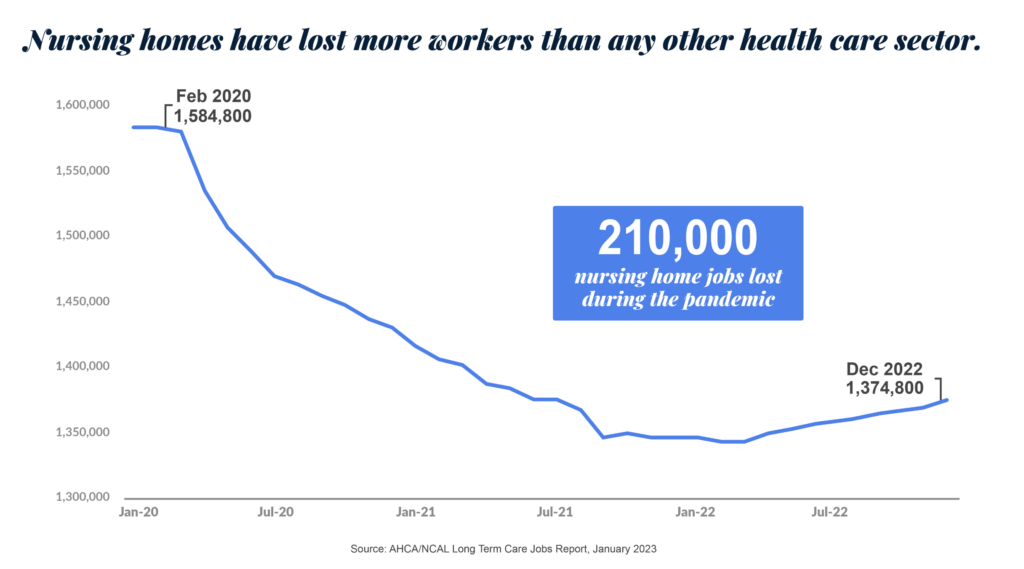Pre-COVID, nursing homes faced chronic Medicaid underfunding, which made it difficult to attract and retain nurses, nurse aides and other critical personnel. The pandemic only exacerbated these staffing challenges, and now long term care faces a historic labor crisis.
The Lowest Workforce Levels in 15 Years
Long term care facilities have lost more than 400,000 caregivers since the start of the pandemic and are facing the worst job losses among all health care providers. Read the latest jobs report.

Caregivers are Burned Out and Dwindling
Frontline caregivers are heroes for serving our nation’s most vulnerable. They continue to do everything they can to protect their residents from COVID-19 and deliver high quality care. But the pandemic has taken an emotional and physical toll, and caregivers are exhausted.
At the same time, the nursing gap is deepening—the United States doesn’t have a pipeline of caregivers ready to fill the void despite a growing elderly population.

1 in 4 health care workers are likely to leave the field in the near future.
The U.S. may see a nursing shortage of between 200,000 and 450,000 registered nurses (RNs) by 2025 if policymakers fail to act.
Dedicating Every Possible Resource
Long term care providers have directed tens of billions of dollars to support their staff during the pandemic—including wage increases, bonuses, PPE, training and more. But with fixed government rates, nursing homes on shoestring budgets lack the resources to make additional investments in their workforce.
- Nursing home workers saw wage increases in 2020 (9.5%) and 2021 (6.3%) that outpaced those working at other types of care facilities.
- For nurses working in nursing homes, average wage rates doubled from 2020 to 2021.
Increasing Need for Temporary Staff
In order to ensure residents receive the around-the-clock care they need, many facilities are having to increasingly rely on temporary agencies to fill staffing shortages. There are widespread concerns that these staffing agencies are exploiting the pandemic and the health care labor shortage by inflating prices beyond reasonably competitive levels, depleting providers of precious resources needed to invest in full-time staff.
- Rates for contracted and agency nurses are 2-3 times higher than pre-pandemic rates.
- More than 78% of nursing homes are having to hire expensive agency staff.
Unfunded Staffing Mandates Would Worsen the Crisis
Proposals to increase staffing minimums in nursing homes won’t solve this labor crisis. The industry needs resources and support to help recruit and retain more frontline caregivers. A recent study found that increasing staffing ratios would:
- Cost $11.3 billion a year
- Require hiring more than 191,000 nurses and nurse’s aides
- Put more than 450,000 nursing home residents at risk of displacement, as facilities may be forced to limit the number of residents they can serve
How Seniors Are Impacted
The labor crisis has a direct impact on seniors’ access to long term care. When long term care facilities do not have enough staff, they must limit the number of residents they can serve. Some facilities are closing altogether because of staffing shortages.
- 55% of nursing homes are limiting new admissions due to a lack of staff.
- More than two-thirds of nursing homes are concerned workforce challenges might force them to close.
The result: seniors who need care are put on waitlists, family members must expand their search and drive farther to see their loved one, and hospitals are overwhelmed with patients who should be discharged.
Meanwhile, with a growing elderly population, the demand for long term care is only increasing.
Potential Solutions to Address Workforce Challenges
To address the challenges faced by the senior care workforce, several potential solutions can be considered:
- Increase wages and benefits for caregivers to attract and retain qualified staff.
- Provide opportunities for training and career advancement to encourage long-term commitment to the field.
- Implement policies that support work-life balance and address caregiver burnout.
- Offer on-demand pay to caregivers so they can cover their immediate financial expenses.
- Develop targeted recruitment strategies to attract new talent to the senior care workforce.
- Foster collaboration between stakeholders, including government agencies, service providers, and advocacy groups, to share resources and best practices.
Reference
Save Our Seniors. (2023, May 11). Save Our Seniors. https://saveourseniors.org/workforce/

